This is Part 2 of an article that began in 2022 when I contributed material for the book Sock Hops and Snowball Dances: A Look Back at Whatcom County Rock and Roll 1955–1980 by Kent Holsather and Wes Gannaway. Anyone who’s read Part 1 in the series knows that in the 1950s the three Bellingham radio stations were all playing easy listening pop music. Records that could be categorized as rock ‘n’ roll were off limits. Part 2 picks up where Part 1 left off. The focus here is on the Top 40 radio format coming to Bellingham, WA. If you haven’t read Part 1, and you’d like to, please click HERE. …..Steven L. Smith
College Radio Western Style

Bellingham radio stations avoided playing rock ‘n’ roll in the 1950s and early-’60s, but there was a notable exception. Viking Roundtable began as a live weekend radio show produced by students at Western Washington College of Education (now Western Washington University). Viking Roundtable first appeared on KVOS radio in December 1955 (two decades before KUGS, Western’s low-power campus FM station, came into being).
Short-lived at KVOS, by February 1956 Viking Roundtable had moved to KPUG. The student announcers talked-up campus happenings and sports. In fall 1956, the name was changed to Viking Turntable. That new name brought popular music into the show. Gary Bruno, Buzz Lawrence, Trev Barrett, Tom Bettis, Judd Lloyd, Stan Pownal, Dick Kure and Duayne Trecker (later an employee of KVOS radio and TV) were the student announcers/deejays. Bruno, Lawrence, and Barrett also wrote the similarly named weekly music column “Turntable Downbeat” for the “Western Collegian” student newspaper (now the “Western Front”).
Students Ran the Show
In the beginning, the student deejays weren’t all that adventurous. They played swing and dance tunes their parents would have liked: the Glenn Miller Orchestra, Tommy Dorsey’s band, Harry James, Benny Goodman, Artie Shaw, Louis Armstrong and Ella Fitzgerald. As the show evolved, the Collegian reported that the most often played artists were Harry Belafonte, Teresa Brewer, Guy Mitchell, Nat King Cole, Frank Sinatra, Dean Martin, Frankie Laine, the Four Lads, and the Dave Brubeck Quartet.

Viking Turntable was subject to changes. Originally running Friday nights, it moved to Saturday nights and then to Sunday nights. At one point, the length of the show was expanded to three hours, but the usual running time was about one hour. Popular music was being redefined nationally and mid-1950s Western students weren’t unanimously sold on early rock ‘n’ roll. A “Turntable Downbeat” columnist expressed the opinion that he’d take easy listening pop music over Elvis Presley any day of the week. Not everyone felt that way: Student deejay, and Western football letterman, Gary Bruno liked the new “rock” sound. In fact, nearly 70 years later, Bruno holds the distinction of having been the first deejay to host a rock ‘n’ roll radio show in Whatcom County.
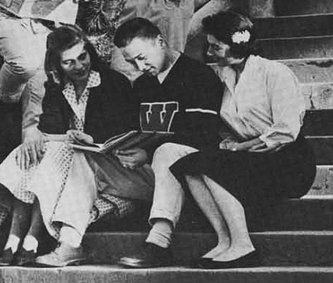
Rockin’ In the New Year – January 1957
Bruno’s unprecedented Viking Turntable rock ‘n’ roll show ran on KPUG on January 5, 1957. The ”Turntable Downbeat” column reported that Bruno played all rock ‘n’ roll records that night and Fats Domino was the featured artist. The student body was polled to see if they wanted to hear more rock music. The answer was a resounding “yes.” Students began leaving song requests at a drop-off location on campus. Bruno gained a reputation as the guy who played rock ‘n’ roll on the radio. A bit of trivia: At Western, Gary was introduced to Karen Gerard — a standout college debater. That introduction was arranged by Bruno’s speech professor, who happened to be former KPUG announcer Paul Herbold. Bruno and Miss Gerard wed in the early-sixties and they are still together.

Bring Your Own Records, Kid!

With many important radio milestones in his rear view mirror, Gary Bruno recently looked back at his time with Viking Turntable: “When I began playing rock ‘n’ roll, KPUG’s record library wasn’t of much help. They didn’t have any early rock music. The record industry reps and distributors in Seattle didn’t ship rock ‘n’ roll records to stations that didn’t play the product. At best, in ’56-’57, KPUG had the modest beginnings of an easy listening pop library: June Christy, Doris Day, Frank Sinatra, Perry Como, Stan Kenton, Al Martino, the Kingston Trio, the Brothers Four, Jimmy Dean and Pat Boone.
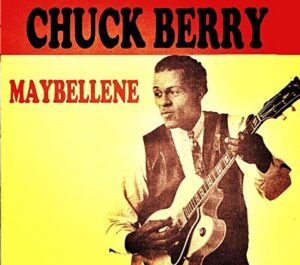 “KPUG deejays weren’t supposed to play rock ‘n’ roll, but I got by with it because the Viking show was sponsored by Western. It was the college’s block of time and we students had some degree of artistic freedom. Trying to find rock ‘n’ roll records was the big challenge. I played music that came from my personal and small record collection. Sometimes I borrowed records from friends and I would play selections from KPUG’s pop library if the songs fit in with what I was doing. When I could get my hands on their records, I much preferred to play Fats Domino, Chuck Berry, Lloyd Price, the Coasters and other cutting edge early rock ‘n’ roll artists.”
“KPUG deejays weren’t supposed to play rock ‘n’ roll, but I got by with it because the Viking show was sponsored by Western. It was the college’s block of time and we students had some degree of artistic freedom. Trying to find rock ‘n’ roll records was the big challenge. I played music that came from my personal and small record collection. Sometimes I borrowed records from friends and I would play selections from KPUG’s pop library if the songs fit in with what I was doing. When I could get my hands on their records, I much preferred to play Fats Domino, Chuck Berry, Lloyd Price, the Coasters and other cutting edge early rock ‘n’ roll artists.”
Influenced by Red in Vancouver

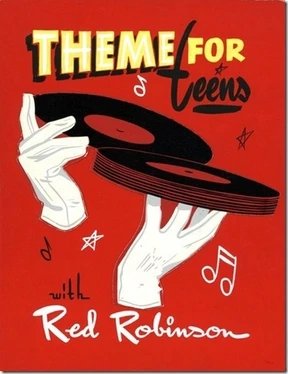 “I wasn’t Bellingham’s answer to Red Robinson in Vancouver BC, Bruno explained, “but I did what I could to promote rock ‘n’ roll. Red had a big influence on me. Vancouver stations bounced across the Strait of Juan de Fuca and into Sequim where I lived as a kid. When I was a high school senior, I heard Red’s Theme for Teens on CJOR. I was at Western when I heard Teen Canteen, the next generation of his show. I sometimes listened to KJR in Seattle in the late-’50s, but it was Red who introduced me to the stuff that made my mouth water: Chuck Berry, Bill Haley, early Elvis, Fats Domino, Ernie Ford, Buddy Holly, rockabilly by Johnny Cash, Carl Perkins and Eddie Cochran, and early rhythm and blues (R&B) from Little Willie John. As the 1950s ended, Red was playing Ritchie Valens, Big Bopper and rhythmic R&B by the Skyliners, Lloyd Price, Chubby Checker, and the Coasters.
“I wasn’t Bellingham’s answer to Red Robinson in Vancouver BC, Bruno explained, “but I did what I could to promote rock ‘n’ roll. Red had a big influence on me. Vancouver stations bounced across the Strait of Juan de Fuca and into Sequim where I lived as a kid. When I was a high school senior, I heard Red’s Theme for Teens on CJOR. I was at Western when I heard Teen Canteen, the next generation of his show. I sometimes listened to KJR in Seattle in the late-’50s, but it was Red who introduced me to the stuff that made my mouth water: Chuck Berry, Bill Haley, early Elvis, Fats Domino, Ernie Ford, Buddy Holly, rockabilly by Johnny Cash, Carl Perkins and Eddie Cochran, and early rhythm and blues (R&B) from Little Willie John. As the 1950s ended, Red was playing Ritchie Valens, Big Bopper and rhythmic R&B by the Skyliners, Lloyd Price, Chubby Checker, and the Coasters.
“When I became a radio deejay, Red and I became friends. When Karen and I were married in 1963, I asked Red to be my best man. That was our plan, but there was a delay at the international border crossing and Red and his wife were unable to make it to our wedding ceremony. They persevered and arrived at our wedding reception, but that was about the same time we were heading out on our honeymoon.”
Bruno’s Career

Gary Bruno has great memories from his broadcasting career. Shortly after leaving KPUG in 1963, he worked as a disc jockey in several major markets (air name Gary Taylor). In 1969-1972, he served as the program director (PD) at legendary KJR in Seattle. From 1974 to ’80, he was the managing editor of the “Gavin Report” — a San Francisco based trade publication that was an important tool for American and Canadian radio station music directors and programmers. For a number of years, Gary was a VP/GM in San Francisco, Spokane and Seattle. In that capacity, he was in charge of several northwest radio stations. In 1986, he became the senior vice president of Transtar/Unistar in LA. The largest satellite network in America, the company provided 24/7 programming to more than 1000 radio stations across the country. A fond memory of his time at Transtar was meeting comedian and actor John Candy. Gary was with the satellite network in 1989 when it was acquired by Dick Clark of American Bandstand fame.
Blackboard Jungle
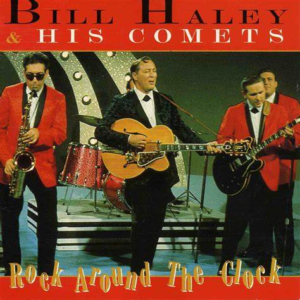 The common narrative goes that 1950’s era American teens were starved for rock ‘n’ roll. Why? Because their panicked and overly protective parents were afraid the sexually charged rhythms and lyrics would lead to moral depravity among their offspring. In 1955, the first big rock ‘n’ roll themed motion picture, The Blackboard Jungle, was at the epicenter of the ruckus and it fed the frenzy. As Bill Haley & His Comets belted out “Rock Around the Clock” on the soundtrack, on the big screen gangs of juvenile delinquents and vandals, including actor Sidney Poitier, were seen assaulting, knifing and terrorizing teacher Glenn Ford and other faculty at a racially integrated New York City high school.
The common narrative goes that 1950’s era American teens were starved for rock ‘n’ roll. Why? Because their panicked and overly protective parents were afraid the sexually charged rhythms and lyrics would lead to moral depravity among their offspring. In 1955, the first big rock ‘n’ roll themed motion picture, The Blackboard Jungle, was at the epicenter of the ruckus and it fed the frenzy. As Bill Haley & His Comets belted out “Rock Around the Clock” on the soundtrack, on the big screen gangs of juvenile delinquents and vandals, including actor Sidney Poitier, were seen assaulting, knifing and terrorizing teacher Glenn Ford and other faculty at a racially integrated New York City high school.
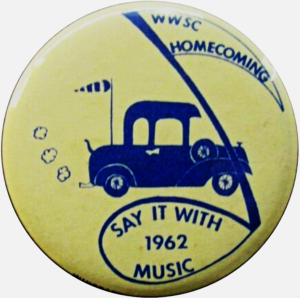
Gary Bruno, a guy who was in tune with late-’50s trends in Whatcom County, has a different take on alleged rock ‘n’ roll deprivation: “I can’t speak for everywhere, certainly not on the national scene, but to describe teens and students as feeling rock ‘n’ roll deprived wasn’t true in Bellingham or at the college. Most young people I knew weren’t overly concerned about rock ‘n’ roll or R&B. They were quite content playing their pop records: Harry Belafonte, the Four Freshman, the Four Lads, Louis Armstrong, the Fleetwoods, the Kingston Trio, Rosemary Clooney and Frank Sinatra. The reality is that pop and early rock ‘n’ roll were both huge parts of the mix that would become the Top 40 radio format.”
Bruno’s sentiments were echoed by 1950’s era sock hop promoter and local radio announcer Dick Goodman. In 1958, prior to hosting a record hop in Bellingham, Goodman told the Bellingham Herald that his intent was to “play the latest records from among the top 100 most popular hits. But there will be less rock ‘n’ roll type music and more slow dances which local young people favor.”
Bruno’s Time-out

Gary Bruno earned his spot in local history as Whatcom County’s first ever rock ‘n’ roll deejay. However, he wasn’t a resident of the county for very long. Coming to Western on a football scholarship, after a season ending injury, he’d lost his scholarship. At the end of spring quarter 1957, Gary left Western and took a fulltime announcing job at KAGT radio in Anacortes. Shortly after, the draft board sent notice that he was being reclassified. Less his student deferment, Bruno saw the writing on the wall. He volunteered for the draft. By doing so, his hitch would be shortened by three months as long as he agreed to go back to college after he’d completed active duty. As Bruno departed Bellingham for his date with Uncle Sam, nobody foresaw that five years later Whatcom County would become reacquainted with Gary Bruno. But that part of this story is yet to come.
Catering to the Younger Crowd

In the late-1950s and the early-’60s, both KENY and KPUG were attempting to broaden their audiences by attracting younger listeners. KVOS, a station comfortable with its position in the community, was disinterested in that pursuit. KVOS had been Bellingham’s first radio station. It was popular with adults and listeners interested in local news, talk, sports, weather and modest doses of mellow music. The owner, Rogan Jones, had married a virtuoso concert violinist and his opinion was that modern pop, rock and Top 40 music should be classified as “musical epilepsy” and “instrumentalized hysteria.” In light of Jones’ distaste for modern music, and the station’s sound footing with adults, the birth of Top 40 radio in Whatcom County involved almost exclusively two radio stations: KPUG and KENY.
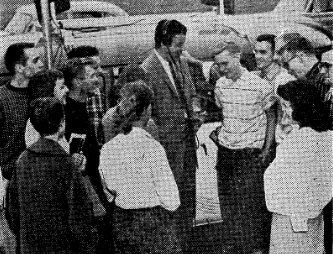
Beginning in the mid-’50s, KPUG had broadened its appeal to younger listeners by running Viking Turntable. Then, on Friday and Saturday nights in 1959, disc jockey Lee White had hosted Club 1170 — a request show. If the kids wanted to hear pop tunes all was well. If they requested rock ‘n’ roll that was a different story. KPUG didn’t play rock ‘n’ roll — even late at night! Also, in the late-’50s, KPUG began sponsoring free kid’s matinees at the local movie theater. That played well with young parents. In the summer of ’61, KPUG broadcast live from a “School’s Out” teen dance that took place in a grocery store parking lot.
KENY, trying to cultivate its own youthful audience, provided the Shuksan Junior High School pep club with kid friendly records to help spice up the club’s hands-on pom-pom making parties. Aiming older, KENY disc jockeys broadcast live and took the station’s promotional Volkswagen van to homecoming, and selected special events, at Western. In spring 1959, a new student radio show, This is Western, debuted on KENY. (Viking Turntable had previously ended its run on KPUG.)

KENY 930 AM
Taking the Plunge
KENY was the first radio station in Whatcom County to jump into a Top 40 format. Dick Stark was there: “I was a Western student and about Thanksgiving 1959 I’d taken a part-time announcing job at KENY. A daytime only station, the FCC required us to sign off at sundown. In the winter that was as early as 4:15 pm and in the summer as late as 9:15 pm. Year-round, I worked long hours on weekends but, depending on the season, my weekday shifts could be short or not at all. That is why I called my show Stark ‘til Dark.
“When I got there, KENY’s format was easy listening pop music. We began our shows by playing a female vocalist. That was followed by a male singer. The third record in the rotation had to be by a group. We repeated that sequence throughout the day. In early-1960, our pop playlist was expanded to include a few of the early rock ‘n’ roll records. Listeners let us know they liked that change and that marked the beginning of KENY’s Top 40 format.”

KENY’s run as a Top 40 station coincided with calendar year 1960. The on-air lineup had station owner, Tom Haveman, in the mornings. Paul Schuett, who’d left KPUG to become KENY’s PD, took middays. Les Beigel, the afternoon personality, was raised in Seattle. Fresh out of broadcasting school, KENY was the first stop in his radio career. Young Les understood music and entertainment. His dad, Les Sr., had traveled the world playing the trumpet in Glenn Miller’s Orchestra. Les’ signature on-air line was “This is Les Beigel barkin’ at you.” The Western student with the show Stark ’til Dark did weekends and evenings — at least until darkness descended on Bellingham and he had to sign off the air.

KENY’s Top 40 Format
Subtle changes were key to KENY’s Top 40 format. Dick Stark recalled, “Dinah Shore, Mantovani, Mitch Miller, Lawrence Welk and records that appealed mostly to older listeners were eliminated or at least played less often. Younger artists — Connie Francis, Elvis, Ricky Nelson, Brenda Lee, the Fleetwoods and Ray Charles — were added to the playlist.” Following up on Stark’s observations, initially radio programmers found that fine-tuning a Top 40 format was all about adding and omitting a few records. There were variations within the Top 40 format. Some stations expanded their playlists to include the top 50 hit records. In large markets, stations might have tightened their playlists to fewer than 40 hit records. Later on, in the mid-’60s and ’70s, psychedelic and heavy metal recording artists such as Jefferson Airplane, Led Zeppelin and Hendrix began showing up on Top 40 playlists. That led to obvious contrasts between Top 40 stations and more refined adult contemporary or pop stations that steered clear of psychedelic or heavy metal sounds.
KENY’s Ratings Rocked!
The Top 40 format spiked KENY’S ratings. In summer 1960, the upstart station’s listenership matched or beat KPUG and KVOS in some dayparts. That was impressive for a new daytime only radio station. Seventeen-year-old Les Beigel had the best ratings of all. When the teens broke out of school in the afternoon, he and KENY topped the ratings in Whatcom County according to a Pulse Report survey.

Fun While it Lasted
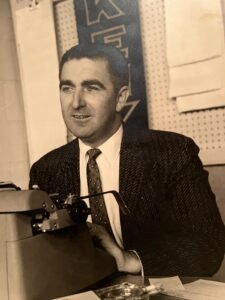
The future looked bright for KENY. Ed Marroy, an experienced advertising salesman, was the sales manager. The revenues were consistently rising for the fledgling radio station, then things began to unravel. In summer 1960, PD and midday jock Paul Schuett left for a job at a radio station in Pasco. The biggest blow hit at year-end 1960 when Tom Haveman laid off the KENY air staff – except for Dick Stark. With Schuett already gone, the biggest loss was Les Beigel (and some part-time announcers). “Tom had financial problems,” Stark recalled. “KENY had good ratings and sales were on the upswing, but it was a new station with insufficient startup cash. The revenues wouldn’t support the payroll. Tom decided to save money by automating. Simultaneously, he dropped the Top 40 format and went back to playing easy listening music. I think he kept me because I was eager to try my hand at selling advertising and I had local connections. For on-air he needed a utility guy: I could read the news, sports, weather or whatever it was that Tom needed.”
After the shakeup, by February 1961, Les Beigel was on the air at Seattle Top 40 station KUDY. By 1964, he was at KREN in Renton and in 1966 he moved to KOL — one of Seattle’s leading Top 40 stations. Les hit the big time, hired by KFWB in Los Angeles, in 1967. Eventually, moving into film narration and voiceovers, Beigel became a much sought after Hollywood voice actor.
Automated KENY
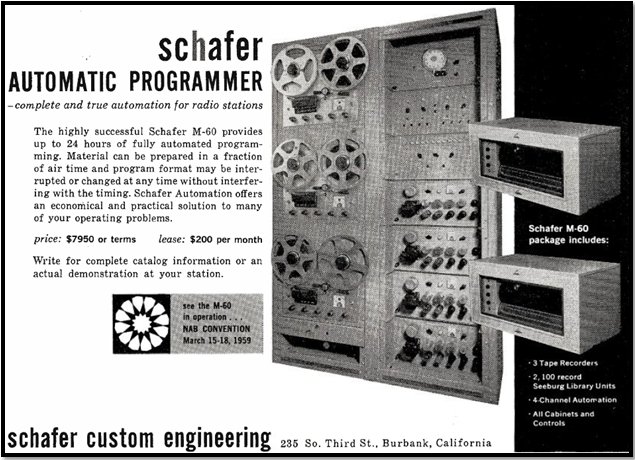
Tom Haveman, with the assistance of an early Schafer radio automation system and audio recording tape, had taken over most of the announcing duties at KENY. Dick Stark remembered automated KENY as a very different radio station: “With Les and the live announcers we were having fun. There was energy and enthusiastic listeners. We got lots of phone calls and song requests. Immediately after the automation replaced the announcers, the fun and excitement ended. With the deejays gone, and the early rock ‘n’ roll records gone too, it was no wonder our younger listeners disappeared overnight.” Click HERE to learn more about the early days of KENY radio.
The Sounds of KENY
Old airchecks from KENY radio probably don’t exist anywhere. With the exception of Paul Schuett, QZVX has obtained 50-year-old recordings of the voices of Tom Haveman, Les Beigel and Dick Stark. In the first track, Haveman was speaking at a celebratory event for his former employer KVOS radio. He’s introduced by longtime KVOS announcer Haines Fay. That leads into Haveman presenting a newscast on KVOS-TV. The second track is from an audition tape/aircheck produced by Les Beigel when he was in LA. Finally, the third track is a Dick Stark sportscast of a Western game from winter 1961. (The earliest known recording of Dick Stark, it ran on KPUG shortly after he’d left KENY.) Click on the audio player, underneath the newspaper clipping, to hear the voices of KENY radio.

(1) Tom Haveman speaks on KVOS radio in 1960, then his 1987 KVOS-TV newscast. (2) Les Beigel’s mid-’70s audition tape. (3) Dick Stark’s 1961 sportscast from Western. Running time 3:56)
Moving On
After Dick Stark graduated from Western in 1960, he stayed with KENY for most of 1961. When an announcing job opened up at KPUG, he applied and was hired. Also in 1961, Tom Haveman left the employ of his struggling station KENY. Taking a fulltime announcing position at KVOS- TV, Haveman retained ownership of KENY until legal problems with the FCC and financial difficulties forced the station into receivership. Going dark in fall 1967, KENY returned to the air in 1968 with new ownership (Fred Danz of Sterling Recreation Organization). Shortly after taking over, Danz changed the call letters to KBFW.
KPUG 1170 AM

In autumn 1961, during the Cold War years, Dick Stark began his new job at KPUG. The Bellingham Herald clipping above is a reminder that people had more weighty worries on their minds than obsessing too much about Top 40 music. Regardless, life went on in Bellingham. Hired as an announcer, Dick persuaded management to allow him to pursue his passions for sportscasting and advertising sales. Meanwhile, Gary Bruno (former host of Viking Turntable in the late-’50s) had completed his military service and he was back at Western. To make a few bucks, he’d been tending to the automation system at radio KENY. When KPUG’s manager called, Gary enthusiastically agreed to take over the station’s morning show. Chronologically, Bruno and Stark arrived at KPUG at about the same time.
KPUG Didn’t Play Kid’s Stuff!
In 1961, the announcing staff at KPUG included Dave Hall (the PD), Don Pinney (chief engineer), and Gary Bruno. During his morning show, Bruno would sometimes sneak in — amongst the pop songs — a few early rock ‘n’ roll records. When he got caught, Dave Hall would remind him that “KPUG isn’t a kid’s station. We don’t play rock ‘n’ roll.”

Pop or Rock, What’s it Gonna be?
Of course, KPUG and KVOS had different announcers, but in 1961 they played the same brand of mellow pop music — as did KENY after it had abandoned its Top 40 format. KVOS usually beat KPUG in the ratings. For that reason, it hadn’t gone without notice at KPUG that the yet to be established KENY had impressive ratings during its brief fling with Top 40. Bruno and Stark, the new guys, looked at Top 40 radio as the wave of the future. From past experience, they knew the Top 40 format was exciting and it could work. But they were young and not key decision makers at KPUG. Local manager, Jim Tincker, fretted that flipping to a Top 40 format would alienate the station’s established advertisers and many of the regular adult listeners. If a format change was in the offing that decision had to come from the top — from Jessica Longston, the woman who owned KPUG.

Jessica Makes the Move
In Jessica Longston’s time as a broadcaster, her “Longston Enterprises” acquired radio stations in Washington, Idaho, Montana and Oregon. Her largest market station was KAYO in Seattle. Chris Lane, KAYO’s program director, had hefty credentials: He’d jocked in Chicago, been the PD for a competitive group of stations, and he’d held down the PD job at KJR in Seattle. In early-1962, Longston sent Lane to Bellingham on a special assignment — to listen to, and to critique, KPUG.
Visitors from the South
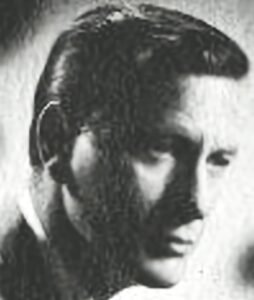
After Chris Lane had completed his review, Longston arranged a programming meeting in Bellingham with KPUG’s manager Jim Tincker, Chris Lane and herself. After the meeting, Gary Bruno recalls that Longston and Lane entered the control room where he was live with his morning show: “They told me KPUG was going to switch to a personality-oriented Top 40 format. I would stay on the morning shift and take over as the music director. Dave Hall would continue on as the PD, but I’d select all of the music. At first Chris Lane was our music and programming consultant, but once the Top 40 format was up and running he took a hands-off approach.”
Top 40 KPUG

The transition to a Top 40 format took place in the spring and summer of 1962. The first KPUG deejays to introduce the Top 40 format were Bruno in the mornings and Dave Hall in the middays. Soon after, young Danny Holiday (Bruno’s friend from Anacortes) arrived in Bellingham to take over afternoons. In the summer, when Britain was falling for the Beatles, T. Michael Forney arrived from Great Falls, Montana. He settled into the evening and night shift. In November 1962, Forney became the subject of local lore when he played the new release Telstar, by the Tornados, 43 times in a row. (Click HERE to read that story and to hear an aircheck from that memorable night.)
As Bruno, Hall, Holiday and Forney played the Top 40 hits, the aforementioned Dick Stark was handling sports and selling radio ads. Stark became a Whatcom County sports legend, working at KPUG for 56 years. The news director, when KPUG went Top 40, was John Sandifer. He is remembered in the northwest as a longtime television news reporter/anchor in Seattle and Spokane. Below are photos of the six original KPUG Top 40 on-air announcers.

The “Live Guys”
The term “live guys” applied to the KPUG on-air staff for the better part of three decades. It traced back to the Top 40 format change. In 1962, as the transition took place, competitors KENY and KGMI (new call letters at KVOS radio) had already gone with the “canned” sound of automation. KPUG wanted to draw attention to its live and lively air sound by promoting the “live guys,” consequently they appeared at remote broadcasts, they played slow pitch softball, they participated in celebrity basketball, and they helped-out with fundraising for local schools and charities. The photos below illustrate that point. Gary Bruno, Dick Stark and John Sandifer emceed the 1962 Miss Birch Bay pageant. During the festivities, Bruno and Stark posed with the contestants. Also on display is an Albertson’s newspaper ad that promoted in-store appearances by the KPUG “live guys.”
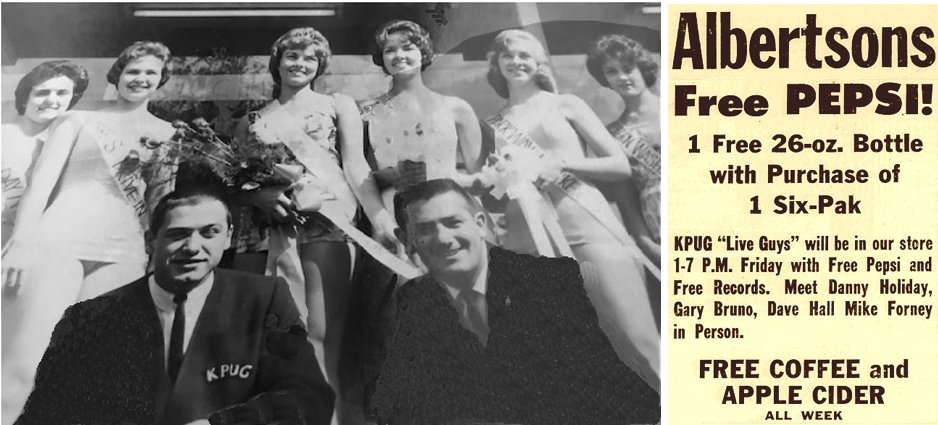
KPUG Aircheck
The voices and photos of all of the six original KPUG “live guys” — Gary Bruno, Dave Hall, Danny Holiday, Mike Forney, Dick Stark and John Sandifer — are included in the next video. Many of the airchecks are from 1960’s era KPUG (exceptions are noted in the captions on the video).
Where Did All Those Records Come From?

In a time of big city radio PDs and music directors being caught up in illegal payola scandals, Gary Bruno remembers that the hardest part of being a music director in a small market was simply obtaining decent records: “KPUG was small market radio. Record execs weren’t all that generous with their records. Some small market stations paid for record service. Instead, Danny Holiday and I regularly visited the record companies in Seattle. We’d twist the arms of the A&R (Artists and Repertoire) reps. Then we developed relationships with the promotions people, those persons responsible for getting new singles into the hands of disc jockeys. It was slow going, but ultimately it was effective and certainly worth the effort.”
A Moment in Time: June 1963
In a flashback to the earliest days of KPUG’s Top 40 format, Gary Bruno has saved an aircheck from 1963. KPUG had been playing Top 40 music for one year. In a promo featured here, Gary describes the breadth of KPUG’s Top 40 music library. A classic Rainier Beer spot is featured within the 60-year-old aircheck as are songs by the Brothers Four, Joanie Sommers, Andy Williams and Brenda Lee.
(KPUG music promo and brief aircheck, Gary Bruno, spring 1963. Running time 3:54)
Right Place, Right Time
KPUG’s transition to Top 40 came at the right time. In the early-’60s, a large segment of Whatcom County’s population consisted of baby boomers. And those boomers grew up listening to the hits on KPUG. In summer 1962, the Barr Electronic survey determined that KPUG had bolstered its ratings with the new format. That momentum continued on for many years. In summer 1966, the Barr Survey indicated that KPUG’s audience share in every daypart surpassed that of all other competitors.
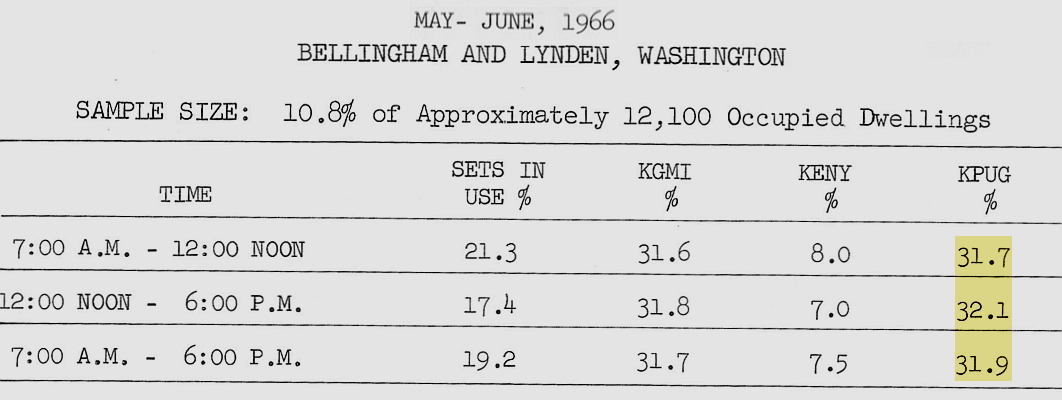
When the Stars Lined up

The Top 40 format made it easy for KPUG to cross-promote with local clubs, bars, restaurants and venues that hosted live music. The team of Bruno, Holiday and Stark, who’d brought pop star Buddy Knox to Bellingham in 1963, continued to sponsor teen dances. When Bruno and Holiday moved away, the tradition was kept alive by Stark and Jim Tincker (their partnership called DJ Enterprises). Beginning in the mid-1960s, DJ Enterprises promoted teen dances and Battles of the Bands. The company operated for 15 years, until teens lost interest in that kind of entertainment.
One of KPUG’s most productive pairings was with Western. The program commission on campus regularly booked major rock, pop, jazz and folk artists. In 1962, the year KPUG went Top 40, Western presented the great Louis Armstrong. KPUG’s Gary Bruno introduced Satchmo. That same year, Australian pop star Rolf Harris, who’d had a hit with “Tie Me Kangaroo Down Sport,” appeared on campus. Western brought in many name artists: Johnny Mathis, Simon & Garfunkel, Ike and Tina Turner, Duke Ellington, the Righteous Brothers, Ray Charles, Jefferson Airplane, Peter, Paul & Mary, the Youngbloods, Country Joe & the Fish, the 5th Dimension, Al Stewart, Maynard Ferguson, Bachman-Turner Overdrive, Deep Purple, Arlo Guthrie, Joan Baez, the Flying Burrito Brothers, Kurt Cobain and many others.

In May 1967, KPUG’s Steve West attended the Righteous Brother’s concert at Western. Norm Gregory was back at the studio. Click below to listen to their broadcast from nearly 60 years ago.
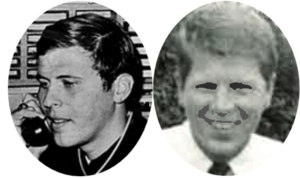
(Steve West and Norm Gregory in the KPUG studio, May 4, 1967. Running time 2:55)
Those Remarkable “Live Guys”
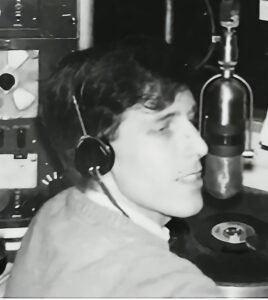
The KPUG disc jockeys tended to be upwardly mobile. Of the original “live guys”, Gary Bruno and Danny Holiday became major players in Seattle radio and similar fields. For many years, John Sandifer was a respected major market television newsman. In 1964, Mike Forney moved to radio station KNEW (later KJRB) in Spokane. A year and a half later, he left radio for a career in business and finance. Dave Hall and Dick Stark stayed at KPUG and its FM sister station until they reached their retirement years.
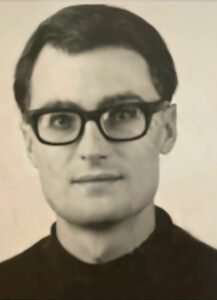
Most disc jockeys were nomadic, moving from market to market, so it’s tricky to identify the second-generation of KPUG “live guys”. KPUG announcers, who were at the station from 1963 into 1965, worked with original “live guy” Danny Holiday (summer 1965 he left for KOL in Seattle). For several decades, anybody employed by KPUG knew Dave Hall and Dick Stark. Hall was in ad sales from 1964 until he retired in the late-’90s. From the very early-’60s on, Stark sold radio time and he was still calling high school and college basketball and football games until 2018. Jocks Jay Hamilton, Russ Ripley, Mike Archer, Mike Dalton, Jerry Valentine, Dean Jones, Kirk Wilde (with sidekick Julius Funkley), and Johnny Jaye arrived at KPUG in the years 1963 through the summer of ’65. They should all qualify as KPUG’s second-generation of “live guys.”
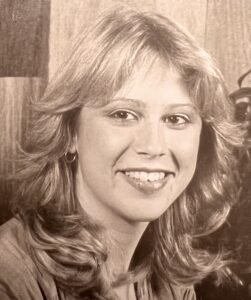
Many KPUG jocks of the 1960s, ’70s, and beyond moved to larger radio markets or to success in related industries. A few notable jocks include Bob O’Neil, Marc Taylor, Gary Shannon, Harvey “Charlie” Brown, Steve West, Norm Gregory, John Christopher Kowsky, Mark Williams, Richard King, George Ruggles, Scott Campbell, Don Patrick, Pat Henry, Greg Collins, Randy “Ichabod Caine” Evans, Charlie Hudson, Dave Hanson, Dan Jurgenson, Marty Rowe, Brian Roc, TJ Powers, LA Marsh, Bruce Butterfield, Steve Lewis, Bob Cochran, Rick Taylor, Frank Schiers, Mark Edwards, Joe Bates, Randy Rowland, Jonathan Walker, Brian Gregory, Keith Shipman, Michael Stein, Greg Cook, and Suzanne Strickland (KPUG’s first female deejay). Glenn Beck, national radio and TV talk show host, was a weekend announcer while he attended Sehome High School in the late-’70s and early-’80s. Mid-’60s jock Ron Gibson ended up in the radio hall of fame in Buffalo, NY under his alias “Cosmic Cowboy Shane ‘Brother’ Shane.” The photo gallery below, encompassing the 1960s-’80s, includes images of several prominent KPUG announcers. They were all deejays, except for Terry Allen, who was the news director, a sportscaster and in ad sales.

Rumor had it
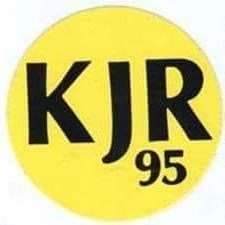 An old tale implies that in the mid-’60s and ’70s KPUG was set up to operate as a training grounds for KJR in Seattle. That wasn’t true, but it’s no wonder the rumor got started: At least seven KPUG announcers ended up at KJR. KPUG and KJR didn’t have mutual business interests. Gary Bruno explained, “As you know, I had worked at KPUG in the early-’60s. Later I became a PD in Spokane at KJR owned KNEW (KJRB). Then I was PD at KJR itself. Being an ex-KPUG employee, I struck a reciprocal deal with KPUG’s manager Jim Tincker. When KPUG needed jocks, I’d send him the names of job applicants I hadn’t hired, but I thought they showed promise. In return, when I was looking for experienced jocks for Spokane or Seattle, Tincker let me check out the KPUG on-air staff as a potential talent pool. When I was PD at KJR, I hired Norm Gregory, Gary Shannon, Charlie Brown and Steve West (all formerly with KPUG). That was evidence that KPUG was a breeding ground for developing a lot of very fine on-air talent.”
An old tale implies that in the mid-’60s and ’70s KPUG was set up to operate as a training grounds for KJR in Seattle. That wasn’t true, but it’s no wonder the rumor got started: At least seven KPUG announcers ended up at KJR. KPUG and KJR didn’t have mutual business interests. Gary Bruno explained, “As you know, I had worked at KPUG in the early-’60s. Later I became a PD in Spokane at KJR owned KNEW (KJRB). Then I was PD at KJR itself. Being an ex-KPUG employee, I struck a reciprocal deal with KPUG’s manager Jim Tincker. When KPUG needed jocks, I’d send him the names of job applicants I hadn’t hired, but I thought they showed promise. In return, when I was looking for experienced jocks for Spokane or Seattle, Tincker let me check out the KPUG on-air staff as a potential talent pool. When I was PD at KJR, I hired Norm Gregory, Gary Shannon, Charlie Brown and Steve West (all formerly with KPUG). That was evidence that KPUG was a breeding ground for developing a lot of very fine on-air talent.”
The Latest News
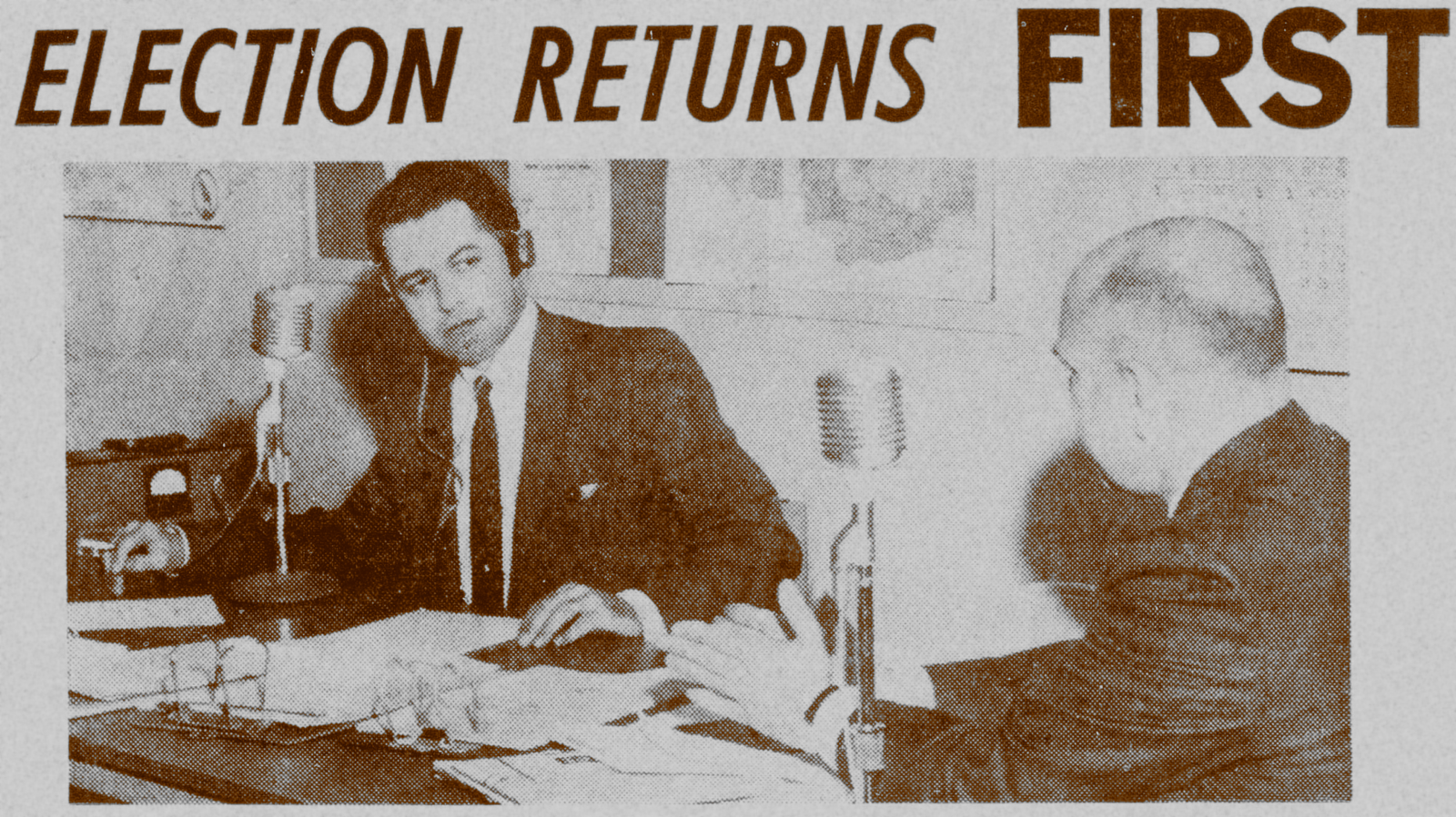

Many capable news directors were employed by KPUG over the years. The news directors had to be highly visible in the community — attending press conferences, covering the police beat, going to tediously long city council meetings, and hobnobbing with business leaders and politicians. A number of former KPUG news directors ended up in Seattle or at other large market radio or TV stations. Some of them eventually wrote for newspapers or maybe they entered public relations or politics. Going way back into the 1950’s, a list of KPUG news directors includes John DiMeo, Bill Anderson, Ed Triplett, John Sandifer, Jack Mayne, Lyle Wallace, Jim Lewis, Terry Allen, Tony Minor, Pete Kremen and Bill Baker. Pete Kremen has an interesting story. He moved to Bellingham in the early-1970s. He began at KBFW and moved to KPUG. In 1984, Pete was elected to the state legislature. After several terms as a state representative, he was elected Whatcom County Executive in 1995. Holding that position for 16 years, and later serving on the county council, Pete is now retired and still living in Whatcom County.
All Good Things Come to an End
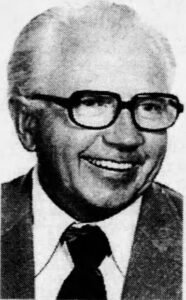
Cross-border signals from Canada, first the big Top 40 AM stations and later the FMs, always had a negative impact on KPUG’s ratings. However, strong ties to Whatcom County advertisers and the community allowed KPUG to thrive for decades. Then, beginning in the late-’70s and peaking in the mid-1980s, the popularity of the FM band overtook that of AM radio. KPUG’s ratings sagged. Fortuitously, KPUG’s Bob Pollock and his management team, had acquired KERI-FM in the summer of 1972. After experimenting with various formats, from easy listening to country, in 1979 that FM morphed into KNWR-Northwest Rock. Ten years later, after new call letters and a format change, it was re-branded as the Soft Rock KAFE.
 By the end of the ’70s, as AM broadcasting was sputtering, KPUG’s format was in flux. Listeners were hearing less music and more talk and sports (from local high school and college games, to NFL and NBA games, Seattle Mariners’ baseball and auto racing). In the early-’80s, any music that remained on KPUG was secondary and promoted as “mellow oldies.” The music stopped once and for all in 1992. That’s when KPUG began to promote itself as KPUG Headline News. Seven years later, it was KPUG Hot Talk-n-Sports. Since the early-2000s, the once dominant Top 40 music station in Whatcom County has been known as KPUG-The Sports Leader.
By the end of the ’70s, as AM broadcasting was sputtering, KPUG’s format was in flux. Listeners were hearing less music and more talk and sports (from local high school and college games, to NFL and NBA games, Seattle Mariners’ baseball and auto racing). In the early-’80s, any music that remained on KPUG was secondary and promoted as “mellow oldies.” The music stopped once and for all in 1992. That’s when KPUG began to promote itself as KPUG Headline News. Seven years later, it was KPUG Hot Talk-n-Sports. Since the early-2000s, the once dominant Top 40 music station in Whatcom County has been known as KPUG-The Sports Leader.
The last time the original KPUG “live guys” got together was in 2002 at a celebration commemorating the 40th anniversary of KPUG’s Top 40 format. Mike Forney couldn’t make it, but everybody else was there.

Epilogue

The first Top 40 FM station in Washington state, KYYX in Seattle, went on the air in 1977. Owned by Seattle broadcaster Pat O’Day, who was synonymous with KJR, the station ran a heavy spot load to help pay the bills associated with O’Day acquiring the station. In March 1981, the New 93 (soon to be KUBE) debuted in Seattle. Recently Michael O’Shea, KUBE’s manager at the time, told QZVX: “We were a well backed new station and could afford to be an all music ‘flame-thrower.’ The reason we surpassed KYYX in our first Arbitron was because we operated commercial free for the first 90 days, while we built our studios. When our studios were finally complete, and we could run spots, we limited them to only eight minutes per hour and we introduced a ‘fifty-one minute per hour MUSIC GUARANTEE’ — with a $10,000 cash prize to any listener who caught us playing less music. In retrospect it was a brilliant (albeit accidental) two year kickoff that caused KYYX to eventually change format, leaving the great KJR-AM as our only competitor at a time when the FM band was taking over the music radio dial.”
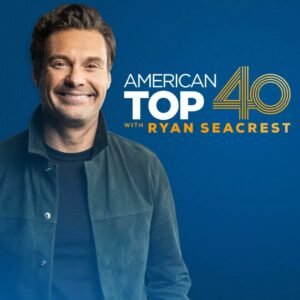 Ultimately, KUBE knocked KJR out of its long held top spot in Seattle. In Bellingham, in the late-’70s and ’80s, KNWR-Northwest Rock and KISM, with morning personality Captain Bill Simmons, ran Top 40 formats. KNWR was turned into the Soft Rock KAFE and KISM settled into a classic rock format. Top 40 stations still exist today. American Top 40 is now hosted by Ryan Seacrest. In December 2023, here’s a list of some of the top artists on the Top 40 singles chart: Taylor Swift, Miley Cyrus, Harry Styles, Selena Gomez, Beyonce, Ed Sheeran, Lady Gaga, Nicky Minaj, and artists with names like Doja Cat, SZA, the Weeknd and Metro Boomin. True to its origins some 70 years ago, the only consistency with the Top 40 format is that it is unpredictable and always changing.
Ultimately, KUBE knocked KJR out of its long held top spot in Seattle. In Bellingham, in the late-’70s and ’80s, KNWR-Northwest Rock and KISM, with morning personality Captain Bill Simmons, ran Top 40 formats. KNWR was turned into the Soft Rock KAFE and KISM settled into a classic rock format. Top 40 stations still exist today. American Top 40 is now hosted by Ryan Seacrest. In December 2023, here’s a list of some of the top artists on the Top 40 singles chart: Taylor Swift, Miley Cyrus, Harry Styles, Selena Gomez, Beyonce, Ed Sheeran, Lady Gaga, Nicky Minaj, and artists with names like Doja Cat, SZA, the Weeknd and Metro Boomin. True to its origins some 70 years ago, the only consistency with the Top 40 format is that it is unpredictable and always changing.
Thank yous and acknowledgements: Dick Stark, Gary “Taylor” Bruno, Mike Forney, Gary “Shannon” Burleigh, Ann Gray (Danny Holiday’s sister), Jay Hamilton, Steve West, Kirk Wilde, Diane “Haveman” Puckett, Bill Hamelin, Dan Strode, Tom Cline (Mark Williams), Keith Shipman (WSAB), Dick Goodman, Paul Watson
Click on the names below to learn the history of these other popular Pacific NW broadcasters:
Danny Holiday (KPUG & KOL)
Dick Stark (KENY & KPUG)
Kirk Wilde (KPUG)
Gary Shannon (KPUG &KJR)
Mike Forney (KPUG)
Jay Hamilton (KPUG & KBFW)
Bob O’Neil & Marc Taylor (KPUG)
John Christopher Kowsky (KPUG & KING)
Haines Faye & Rogan Jones (KVOS & KGMI)
Tom Haveman (KENY & KVOS)
Red Robinson (Vancouver B.C.)
Don Hedman (KJR & KAYO Seattle)
Pat O’Day (KJR & KYYX Seattle)

I will mention it again- Miss Birch Bay Cheri Mariotto later was Miss Tanya, the lady gracing billboards nationwide for Tanya Tanning Butter in the late 1960’s.